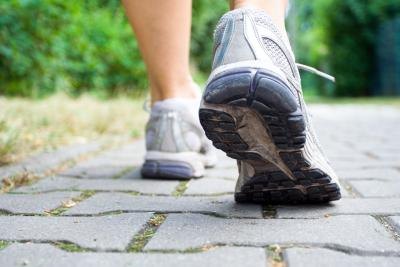Author
by
http://www.livestrong.com/article/290273-walking-shoes-vs-cross-training-shoes/
by
Shoes are essential to your everyday activities. Having the right shoes can make all the difference in how your feet, legs and back feel when you're working out. Walking and cross-training shoes are designed differently, so it's important to select a shoe that's appropriate for the sport or activity you plan to participate in. Cross training shoes are more economical than buying designated shoes for each sport, but you need sport-specific shoes if you're doing a particular activity, such as walking, more than two times a week.
Walking Shoes
Walking shoes are designed specifically for walking and should be used for that purpose alone, not any other sport. As a walker, you will need a low, rounded heel that provides good support. You also want a shoe that weighs little and allows your foot to breathe. You may desire a soft landing in your shoes, but do not overdo the thickness of the sole, as you want it to remain flexible, especially at the toe where your foot bends naturally. Walkers need thinner soles than runners, since their foot-to-ground impact is not as great as that of runners. These shoes have the most cushioning in the heel of the shoe, where your foot hits while you are walking. Walking shoes tend to be built for even surfaces, not for hiking.
Cross-Training Shoes
Cross-training shoes are made for versatility. These shoes are designed to be able to be worn comfortably for a number of activities. They are breathable, but may be heavier than shoes configured for a specific purpose, due to their multipurpose design. These shoes will tend to have a thicker, heavier sole than walking shoes, which can make it stiffer as well. Cross-trainers typically have more support than walking shoes and are built to fulfill a number of physical requirements. You may not need or want all the additions a cross-trainer shoe carries in your walking shoe. However, if you plan on trail walking, cross-training shoes are more likely to be built for a multitude of surfaces than walking shoes.
Where to Buy
When it comes to fitness shoes, the American Academy of Podiatric Sports Medicine recommends that you be fit by a reputable footwear retailer. You may need a certain type of shoe based on your individual gait, range of motion, arch and foot type. Small specialty shops often have the experience necessary to pair you with the correct shoe. If you have a history of foot injuries, visit a sports medicine podiatrist before heading out to buy shoes; a podiatrist will assess your foot type and make specific recommendations.
Shopping
When shopping for your new shoes, bring the right equipment. Bring the socks that you will wear while using the shoes and special inserts if you have any. Note that your feet swell the longer you are on them, so it is best to go shoe shopping at the end of the day, when your feet are at their biggest. Ignore the size, and go with what feels the most comfortable. Depending on the shoe type and brand, you may have to go up or down a half-size or more from your normal shoe size. Lastly, actually perform your desired activity in the shoe while still in the store.
Shoe Selection
When selecting your shoes, make sure that you have adequate room for your toes. Your shoes should be fit with an index finger's width between your longest toe and the end of the shoe. Your heel should be stable and not be able to slip in and out of the shoe. Check the shoes for any obvious defects such as tears and improper stitching.
http://www.livestrong.com/article/290273-walking-shoes-vs-cross-training-shoes/







No comments:
Post a Comment